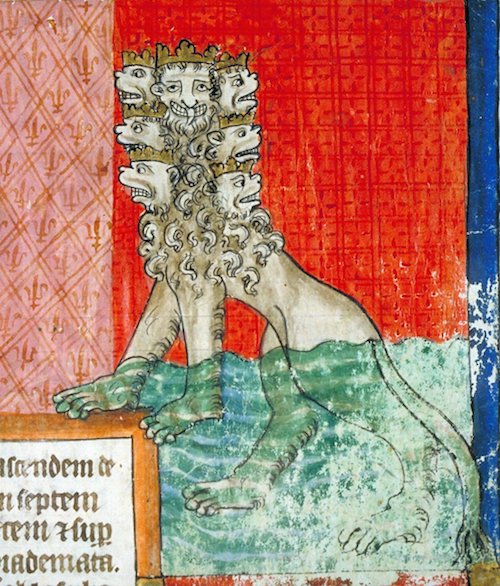We run our website the way we wished the whole internet worked: we provide high quality original content with no ads. We are funded solely by your direct support. Please consider supporting this project.

Is the New Testament Ambiguous About Non-Violence?
One could argue, with some legitimacy, that the portrait of God in the NT is not unambiguously non-violent, the revelation of God on Calvary notwithstanding. It can’t be denied that there are violent-appearing images of God in certain teachings of Jesus and certain NT authors, especially when it comes to their eschatological teachings. In addition, some argue that Jesus cleansing the temple (John 2:19-22) and instructing the disciples to buy a sword (Luke 22:36-37) are examples of the NT promoting violence. And it certainly can’t be denied that the most violent imagery in the NT is found in the book of Revelation. Indeed, some have argued that chapter 19 of this book contains the most violent imagery in the entire Bible. (See post on violence in Revelation.)
I think I’ve demonstrated that there are legitimate ways to interpret these passages in ways that do not promote violence. The links above introduce my perspective and I have thoroughly addressed these questions in the appendices of Crucifixion of the Warrior God. Yet, it can’t be denied that some of these violent images can be interpreted in ways that suggest that God is not altogether opposed to violence. And to the degree one could interpret these passages as depicting God in ways that promote violence, it must be conceded that the NT depiction of God is not unambiguously enemy-loving and non-violent.
In response to the alleged violence in some sections of the NT, I argue that the revelation of God in Christ, thematically centered on the cross, should incline us to privilege it over possibly-violent depictions of God in the NT. Hence, I would argue we should interpret any passage in the NT that could possibly be viewed as God acting violently in the same way we interpret the OT’s unambiguously violent depictions of God. We should, in other words, interpret these ambiguous views of God through the lens of the cross as I propose in Crucifixion of the Warrior God. (See this video that introduces what I mean by this.)
This leads me to a second level of ambiguity; that is, we must wonder if there is any ambiguity in the call for followers of Jesus to unconditionally embrace an enemy-loving, non-violent posture toward all people at all times. On this score, I confess that I don’t see any ambiguity. Indeed, I can’t think of a teaching in the NT that is simpler, clearer, or more uniformly taught than this one. From my perspective, any ambiguity that is alleged to accompany this teaching arises not because there is any difficulty in understanding it, but because theologians throughout history have struggled to integrate its logic.
The NT’s unambiguous teaching about non-violence—including loving enemies—runs directly counter to commonsense intuitions about the justified use of violence in certain personal, social and national circumstances. The prevailing assumption throughout history and yet today is that Jesus and certain NT authors surely weren’t forbidding the use of violence to protect our families or our country. Whatever they actually meant, this commonsensical line of thinking goes, they could not have meant that, for that is patently absurd and foolish!
The fact is that we ought not be surprised that the NT’s teaching on loving enemies strikes us as foolish since Jesus taught that if we only love those for whom it makes sense to love, there is nothing distinctly godly and rewarding about our love. But when we go beyond the conditional kind of love people normally extend to others and instead choose to love and bless even our worst “enemies,” we reflect God’s indiscriminate love in a distinctive way and thus enjoy a unique reward (Mt 5:46; Lk 6:32-33). Our love, in other words, is supposed to look foolish, and this, it seems to me, rules out any possibility of qualifying the NT’s command to love and to refrain from violence on commonsensical grounds. And it removes any ambiguity.
Category: General
Tags: Bible Interpretation, Cruciform Theology, Non-Violence
Topics: Interpreting Violent Pictures and Troubling Behaviors
Related Reading

How NOT To Be Christ-Centered: A Review of God With Us – Part I
Theologians throughout Church history have used the concept of divine accommodation to account for everything in Scripture that seemed “unworthy” of God. Whatever didn’t line up with what we know about God was seen as God accommodating his revelation to our limited and fallen framework. The trouble is, theologians have, by and large, used the…

Podcast: Isn’t God Withdrawing the SAME as Him Personally Punishing and Causing Violence?
Greg discusses whether the passivity of withdrawal is distinguishable from active punishment. http://traffic.libsyn.com/askgregboyd/Episode_0186.mp3

Is Non-Violence a Key to Christian Discipleship?
For the first three centuries of the church, Christians understood that forgoing the use of violence and expressing God’s self-sacrificial love was central to discipleship. However, this mindset changed after the Church acquired power in the fourth century. Entire theological systems have been developed to support the use of coercive power. However, contrary to that…

Podcast: What is Violence?
Greg takes a closer look at what violence is. Then he bullies Dan. http://traffic.libsyn.com/askgregboyd/Episode_0174.mp3


